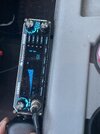Your antenna is too short, but then again, I intentionally cut my 102 down to something about the same so it wouldn't hit CATV lines in town, but I had to make a matching coil for that to work.
Ground to the nearest metal part of the body with the shortest strap possible. Running a ground to the battery or frame through whatever path is available is too much inductance. Remember, the ground connection is the other half of the antenna, and length matters, so feeding it through obscure areas down to the frame or battery terminal simply means it must go right back up to the body to become a counterpoise signal, so just go directly to the body panel/truck box.
If you have an antenna analyzer and could measure the feed point impedance, a coil could easily be designed to tune up that shorter whip. For a simple coil in series to be effective, as mentioned above, the whip should first be cut so the impedance at the feedpoint is on the constant conductance circle going to the center of the smith chart, but if the whip was cut too short for that, a grounded coil with a tapping point would be needed (series and shunt inductance).
A series coil alone has the potential to make the match better, even if the whip were not cut to the proper constant conductance circle. So there is no harm in trying random series coils to see what happens if you do not have an analyzer. If you happen to have a decent nanoVNA, all trial and error could be eliminated.






